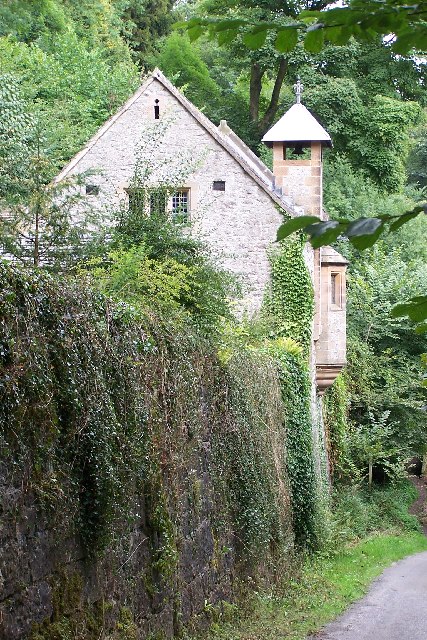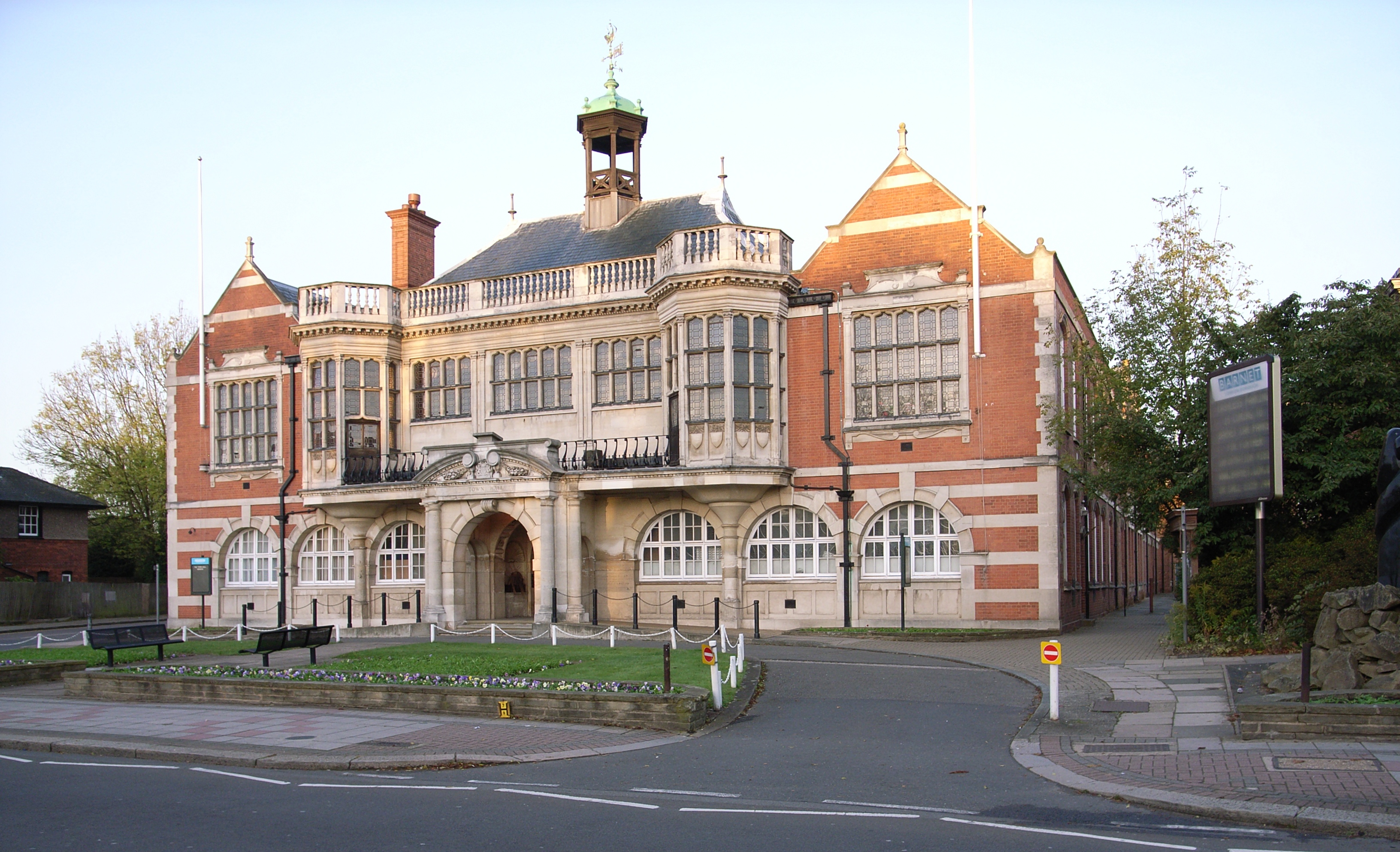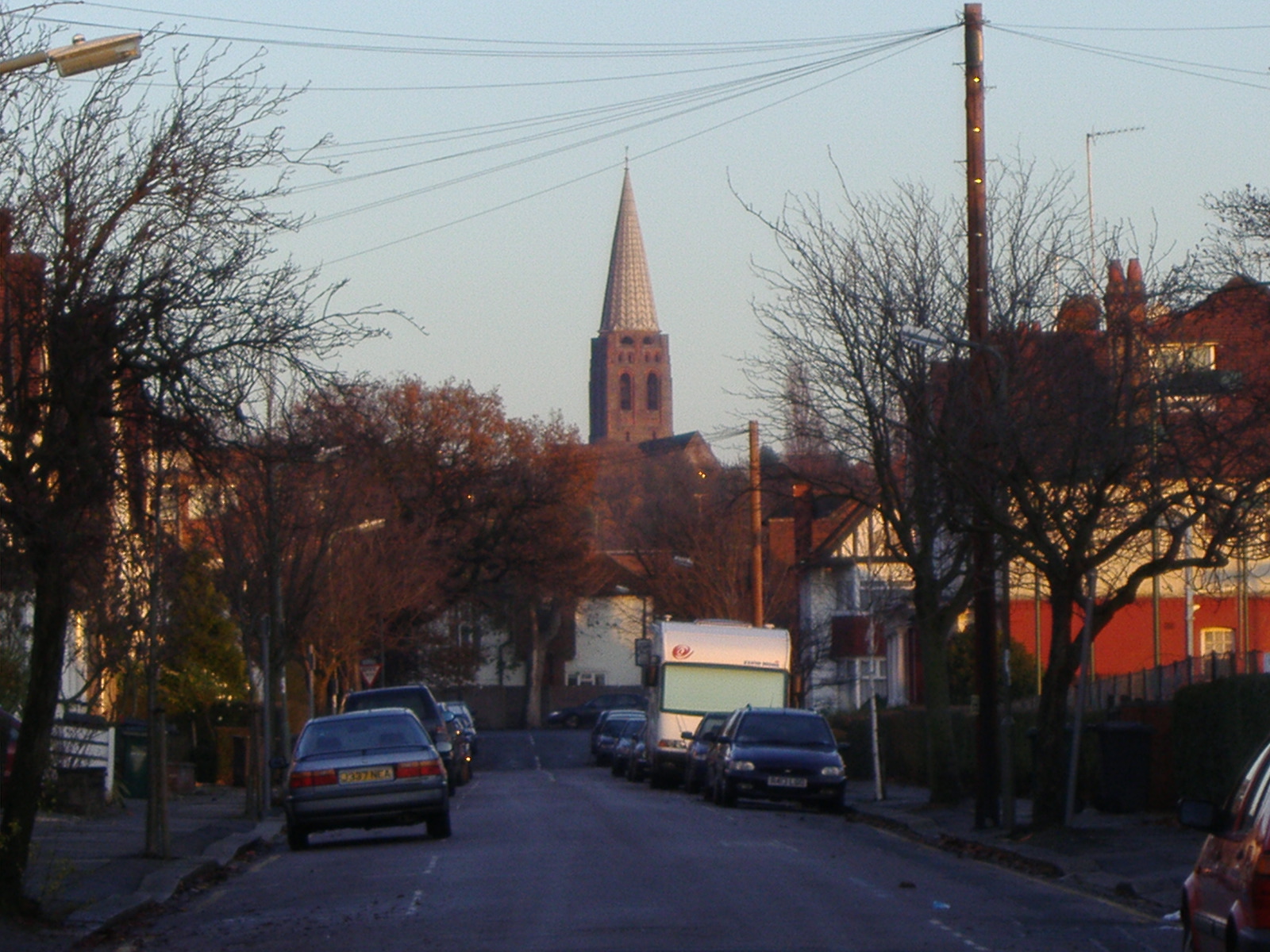|
Guy Dawber
Sir Edward Guy Dawber, RA ( King's Lynn, 3 August 1861 – London, 24 April 1938) was an English architect working in the late Arts and Crafts style, whose work is particularly associated with the Cotswolds. Biography Edward Guy Dawber was born in Britain in 1861, at King's Lynn, Norfolk, the son of a merchant. He trained in the practice of Sir Ernest George and Harold Peto, supervising their work on Batsford Park (1887–93), near Moreton-in-Marsh, in the Cotswolds.In 1896 he married Mary Eccles in Lancashire. In 1897 Dawber designed St John the Baptist's Chapel, Matlock Bath in Matlock Dale, Derbyshire, when he lived locally. It was the only church designed by him. Dawber designed the Old Post Office at 25 High Street, Broadway, Worcestershire, which was built in Cotswold stone by Espley & Co of Evesham in 1899 and opened on Friday 1 December 1899. He also designed Bibsworth House, Broadway. Dawber sometimes also worked on the landscaping of the estates on which his ... [...More Info...] [...Related Items...] OR: [Wikipedia] [Google] [Baidu] |
Chapel Of St John The Baptist, Masson Hillside - Geograph
A chapel is a Christian place of prayer and worship that is usually relatively small. The term has several meanings. Firstly, smaller spaces inside a church that have their own altar are often called chapels; the Lady chapel is a common type of these. Secondly, a chapel is a place of worship, sometimes non-denominational, that is part of a building or complex with some other main purpose, such as a school, college, hospital, palace or large aristocratic house, castle, barracks, prison, funeral home, cemetery, airport, or a military or commercial ship. Thirdly, chapels are small places of worship, built as satellite sites by a church or monastery, for example in remote areas; these are often called a chapel of ease. A feature of all these types is that often no clergy were permanently resident or specifically attached to the chapel. Finally, for historical reasons, ''chapel'' is also often the term used by independent or nonconformist denominations for their places of worsh ... [...More Info...] [...Related Items...] OR: [Wikipedia] [Google] [Baidu] |
Stow-on-the-Wold
Stow-on-the-Wold is a market town and civil parish in Gloucestershire, England, on top of an 800-foot (244 m) hill at the junction of main roads through the Cotswolds, including the Fosse Way (A429), which is of Roman origin. The town was founded by Norman lords to absorb trade from the roads converging there. Fairs have been held by royal charter since 1330; a horse fair is still held on the edge of town nearest to Oddington in May and October each year. History Origins Stow-on-the-Wold, originally called Stow St Edward or Edwardstow after the town's patron saint Edward, probably Edward the Martyr, is said to have originated as an Iron Age fort on this defensive position on a hill. Indeed, there are many sites of similar forts in the area, and Stone Age and Bronze Age burial mounds are common throughout the area. It is likely that Maugersbury was the primary settlement of the parish before Stow was built as a marketplace on the hilltop nearer to the crossroads, to take advanta ... [...More Info...] [...Related Items...] OR: [Wikipedia] [Google] [Baidu] |
Architects From Norfolk
An architect is a person who plans, designs and oversees the construction of buildings. To practice architecture means to provide services in connection with the design of buildings and the space within the site surrounding the buildings that have human occupancy or use as their principal purpose. Etymologically, the term architect derives from the Latin ''architectus'', which derives from the Greek (''arkhi-'', chief + ''tekton'', builder), i.e., chief builder. The professional requirements for architects vary from place to place. An architect's decisions affect public safety, and thus the architect must undergo specialized training consisting of advanced education and a ''practicum'' (or internship) for practical experience to earn a license to practice architecture. Practical, technical, and academic requirements for becoming an architect vary by jurisdiction, though the formal study of architecture in academic institutions has played a pivotal role in the development of the ... [...More Info...] [...Related Items...] OR: [Wikipedia] [Google] [Baidu] |
19th-century English Architects
The 19th (nineteenth) century began on 1 January 1801 ( MDCCCI), and ended on 31 December 1900 ( MCM). The 19th century was the ninth century of the 2nd millennium. The 19th century was characterized by vast social upheaval. Slavery was abolished in much of Europe and the Americas. The First Industrial Revolution, though it began in the late 18th century, expanding beyond its British homeland for the first time during this century, particularly remaking the economies and societies of the Low Countries, the Rhineland, Northern Italy, and the Northeastern United States. A few decades later, the Second Industrial Revolution led to ever more massive urbanization and much higher levels of productivity, profit, and prosperity, a pattern that continued into the 20th century. The Islamic gunpowder empires fell into decline and European imperialism brought much of South Asia, Southeast Asia, and almost all of Africa under colonial rule. It was also marked by the collapse of the la ... [...More Info...] [...Related Items...] OR: [Wikipedia] [Google] [Baidu] |
1938 Deaths
Events January * January 1 ** The new constitution of Estonia enters into force, which many consider to be the ending of the Era of Silence and the authoritarian regime. ** State-owned railway networks are created by merger, in France (SNCF) and the Netherlands (Nederlandse Spoorwegen – NS). * January 20 – King Farouk of Egypt marries Safinaz Zulficar, who becomes Queen Farida, in Cairo. * January 27 – The Honeymoon Bridge at Niagara Falls, New York, collapses as a result of an ice jam. February * February 4 ** Adolf Hitler abolishes the War Ministry and creates the Oberkommando der Wehrmacht (High Command of the Armed Forces), giving him direct control of the German military. In addition, he dismisses political and military leaders considered unsympathetic to his philosophy or policies. General Werner von Fritsch is forced to resign as Commander of Chief of the German Army following accusations of homosexuality, and replaced by General Walther ... [...More Info...] [...Related Items...] OR: [Wikipedia] [Google] [Baidu] |
1861 Births
Statistically, this year is considered the end of the whale oil industry and (in replacement) the beginning of the petroleum oil industry. Events January–March * January 1 ** Benito Juárez captures Mexico City. ** The first steam-powered carousel is recorded, in Bolton, England. * January 2 – Friedrich Wilhelm IV of Prussia dies, and is succeeded by Wilhelm I. * January 3 – American Civil War: Delaware votes not to secede from the Union. * January 9 – American Civil War: Mississippi becomes the second state to secede from the Union. * January 10 – American Civil War: Florida secedes from the Union. * January 11 – American Civil War: Alabama secedes from the Union. * January 12 – American Civil War: Major Robert Anderson sends dispatches to Washington. * January 19 – American Civil War: Georgia secedes from the Union. * January 21 – American Civil War: Jefferson Davis resigns from the United States Senate. * Janua ... [...More Info...] [...Related Items...] OR: [Wikipedia] [Google] [Baidu] |
Moreton-in-Marsh And Batsford War Memorial
Moreton-in-Marsh and Batsford War Memorial stands in Moreton-in-Marsh, Gloucestershire, England, and is a memorial to those of Moreton and Batsford killed in the First and Second World Wars. The erection of the memorial on the High Street began in November 1920. It is built of Hollington stone from Staffordshire, and stands high. The work was carried out by R. I. Boulton and Sons of Cheltenham to Guy Dawber's design. Carved at the top of the memorial are the figures of St. George and the Dragon from the model prepared by the sculptor, Allan Wyon of London. The total cost was around £700, raised primarily from public subscriptions. The memorial consists of an octagonal flight of five steps, upon which stands a sur-base containing panels and surmounted around the top by the inscription "In grateful memory of the men of Moreton and Batsford who gave their lives in the Great War". On four panels are inscribed the names of the forty-four men who died. On a fifth panel was late ... [...More Info...] [...Related Items...] OR: [Wikipedia] [Google] [Baidu] |
London Borough Of Barnet
The London Borough of Barnet () is a suburban London borough in North London. The borough was formed in 1965 from parts of the ceremonial counties of Middlesex and Hertfordshire. It forms part of Outer London and is the largest London borough by population with 384,774 inhabitants, also making it the 13th largest district in England. The borough covers an area of , the fourth highest of the 32 London boroughs, and has a population density of 45.8 people per hectare, which ranks it 25th. Barnet borders the Hertfordshire district of Hertsmere to the north and five other London boroughs: Camden and Haringey to the southeast, Enfield to the east, as well as Harrow and Brent to the west of the ancient Watling Street (now the A5 road). The borough's major urban settlements are Hendon, Finchley, Golders Green, Friern Barnet, Chipping Barnet, Whetstone, and Edgware; there are also village settlements notably Totteridge and Arkley along with rural areas and countryside part o ... [...More Info...] [...Related Items...] OR: [Wikipedia] [Google] [Baidu] |
Hampstead Garden Suburb
Hampstead Garden Suburb is an elevated suburb of London, north of Hampstead, west of Highgate and east of Golders Green. It is known for its intellectual, liberal, artistic, musical and literary associations. It is an example of early twentieth-century domestic architecture and town planning in the London Borough of Barnet, northwest London. The master plan was prepared by Barry Parker and Sir Raymond Unwin. Comprising just over 5,000 properties, and home to around 16,000 people, undivided houses with individual gardens are a key feature. The area enjoys landscaped garden squares, several communal parks and Hampstead Heath Extension. History Hampstead Garden Suburb was founded by Henrietta Barnett, who, with her husband Samuel, had started the Whitechapel Art Gallery and Toynbee Hall. In 1906, Barnett set up the Hampstead Garden Suburb Trust Ltd, which purchased 243 acres of land from Eton College for the scheme and appointed Raymond Unwin as its architect. Among the ... [...More Info...] [...Related Items...] OR: [Wikipedia] [Google] [Baidu] |
Lord Wandsworth College
Lord Wandsworth College (LWC) is a co-educational independent school in Long Sutton, Hampshire, England, for day and boarding pupils between the ages of 11–18, which occupies a 1,200 acre campus and is known for its charitable foundation. It is a member of the Headmasters' and Headmistresses' Conference. Since 2015, the headmaster has been Adam Williams. In 2020, the College was named Independent School of the Year for Student Wellbeing, and was awarded the Schools of Character Kitemark by the Association of Character Education. Notable former pupils Notable former pupils include: * Charlie Amesbury, rugby union player * Grace Blakeley, political commentator, journalist and author * Will Buxton, journalist and broadcaster * Sir Peter Coulson, High Court judge * Scott S. Hall, Professor, Stanford University School of Medicine * George 'Johnny' Johnson, RAF officer with the “Dambusters” * Ugo Monye, rugby union international and broadcaster * Peter Richards, rugby un ... [...More Info...] [...Related Items...] OR: [Wikipedia] [Google] [Baidu] |
London Zoo
London Zoo, also known as ZSL London Zoo or London Zoological Gardens is the world's oldest scientific zoo. It was opened in London on 27 April 1828, and was originally intended to be used as a collection for scientific study. In 1831 or 1832, the animals of the Tower of London menagerie were transferred to the zoo's collection. It was opened to the public in 1847. Today, it houses a collection of 673 species of animals, with 19,289 individuals, making it one of the largest collections in the United Kingdom. The zoo is sometimes called Regent's Park Zoo. It is managed under the aegis of the Zoological Society of London (established in 1826), and is situated at the northern edge of Regent's Park, on the boundary line between the City of Westminster and the borough of Camden (the Regent's Canal runs through it). The Society also has a more spacious site at ZSL Whipsnade Zoo in Bedfordshire to which the larger animals such as elephants and rhinos have been moved. As well as bei ... [...More Info...] [...Related Items...] OR: [Wikipedia] [Google] [Baidu] |









